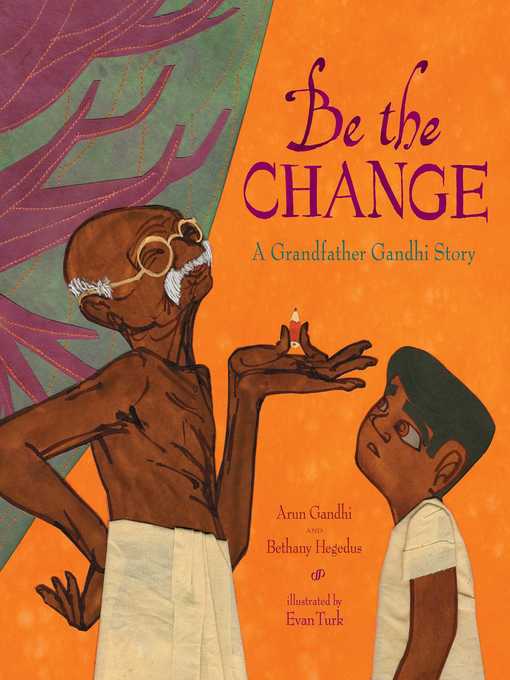
Be the Change
A Grandfather Gandhi Story
فرمت کتاب
ebook
تاریخ انتشار
2016
Lexile Score
610
Reading Level
2-3
ATOS
3.9
Interest Level
K-3(LG)
نویسنده
Evan Turkشابک
9781481442664
کتاب های مرتبط
- اطلاعات
- نقد و بررسی
- دیدگاه کاربران
نقد و بررسی

July 4, 2016
The team behind 2014’s Grandfather Gandhi returns with a second real-life story drawn from Arun Gandhi’s time at the Sevagram ashram with his grandfather, Mahatma Gandhi. After Arun tosses away a pencil nub in defiance of the ashram’s vow not to waste, it leads to an in-depth exploration of the connections between waste and violence. The story culminates with the “Be the change” phrase widely attributed to Gandhi, though actually coined by Arun to represent his grandfather’s ideals. As in the previous books, Turk’s mixed-media images create a vibrant, dazzlingly imagined backdrop for the weighty philosophical discussions at play. Ages 4–8. Authors’ agent: Alexandra Penfold, Upstart Crow Literary. Illustrator’s agent: Brenda Bowen, Sanford J. Greenburger Associates.

June 15, 2016
The creators of Grandfather Gandhi (2014) return with a lesson about the complex foundations of violence in our world.Life for young Arun in the ashram, or "service village," includes many chores. All work for the good of the group, doing basic tasks such as growing food or spinning thread. While these endeavors clearly affect comfort and survival, the benefits of some of the expectations held by his grandfather Mohandas K. Gandhi are less tangible. Arun Gandhi speaks directly to readers, explaining that he struggled particularly with the idea that waste and violence were linked. Through conversation and the creation of a visual aid, his Bapuji helps him to conceptualize the connection and to see that all actions are interrelated. Gandhi and Hegedus' relatively lengthy text is alternately direct and lyrical. Abstract concepts, sophisticated vocabulary, and philosophical explanations may slow some readers down, though unfamiliar words can generally be understood in context. Turk's striking mixed-media illustrations feature vivid colors and varying textures and include decorative stitching that evokes Indian textiles. Exaggerated, stylized shapes and intriguing perspectives complement the complexity of the ideas being explored and illuminate the subdued action of the text. Decidedly and deliberately didactic, the book aims to spark action on the part of listeners, making it a title best shared by adults who are interested in the topic and motivated to continue the conversation. (authors' note) (Informational picture book. 7-10)
COPYRIGHT(2016) Kirkus Reviews, ALL RIGHTS RESERVED.

Starred review from July 1, 2016
Gr 2-6-Following Grandfather Gandhi, this title finds young Arun at his grandfather's ashram, or "service village." Slightly older now, the boy is working to adhere to the 11 vows of ashram living. Not wasting is the most difficult for him, and he has trouble understanding how this vow relates to nonviolence. Three incidents combine to help Arun learn the lesson. He accompanies his grandfather (Bapuji) on a trip and listens as he tells a crowd, "When nonviolence is accepted as the law of life, it must pervade the whole being and not be applied to isolated acts." On the way home, Arun tosses away a pencil stub. When Bapuji finds out, he sends Arun back in the dark to retrieve it, saying, "It is not the pencil, but you, that is important," meaning that Arun's grandfather loves him enough to hold him accountable. The third way that Grandfather teaches Arun is by helping him make a "tree of violence," a chart on the wall that shows how seemingly small actions or thoughts can lead to larger events. The illustrations, especially the visualization of Arun's tree, help children understand the weighty concepts. As he adds to it each day, it grows beyond the physical walls, dwarfing Bapuji and Arun and demonstrating that each decision takes a person on a particular path. The dramatic collage illustrations include dimensional elements to create the illusion of texture. The full-bleed spreads immerse readers and take them on the journey with Arun. Constantly shifting perspective moves from small to large and close to far, reiterating the theme of a small action having larger consequences. Another repeated motif is the use of frames within larger images to demonstrate connectedness. VERDICT This handsome book asks a lot of young readers but carries important messages delivered in a personal and relatable manner.-Lucinda Snyder Whitehurst, St. Christopher's School, Richmond, VA
Copyright 2016 School Library Journal, LLC Used with permission.

June 1, 2016
Grades K-2 In this follow-up to Grandfather Gandhi (2014), Arun Gandhi once again revisits his childhood in an Indian ashram, recounting one particular memory of his grandfather, the Mahatma. Ashram life, Arun says, revolved around a pledge of nonviolence, including a vow not to waste. Frustrated with this, a young Arun throws aside the pencil nub he's been using. Instead of giving him a new pencil, his grandfather sends him out to find the old one. Slowly, Gandhi begins to teach his grandson about passive violence and the effects small actions can have on the world. Some of the nuances of the message may be lost on younger readersas initially they are on young Arunbut the illustrations are a joy. Turk's gloriously colorful multimedia collages capture the spirit of the story while providing endlessly fascinating details, and repeating shapes reflect Arun's growing understanding of the interconnection of actions, ultimately driving home one of Gandhi's most enduring lessons: to change the world, first change yourself.(Reprinted with permission of Booklist, copyright 2016, American Library Association.)

























دیدگاه کاربران